




 We are designing a new era - energising, electrifying, and exhilarating. Building on our fundamental strengths of engineering and innovation with a human
centric, hi-tech approach, we are Moving India forward. We are redefining logistics to accelerate the wheels of the economy; connecting people and communities,
their thoughts, ideas, dreams. Igniting the spark of adventure, creating a sense of fulfilment, enabling a life of purpose
We are designing a new era - energising, electrifying, and exhilarating. Building on our fundamental strengths of engineering and innovation with a human
centric, hi-tech approach, we are Moving India forward. We are redefining logistics to accelerate the wheels of the economy; connecting people and communities,
their thoughts, ideas, dreams. Igniting the spark of adventure, creating a sense of fulfilment, enabling a life of purpose

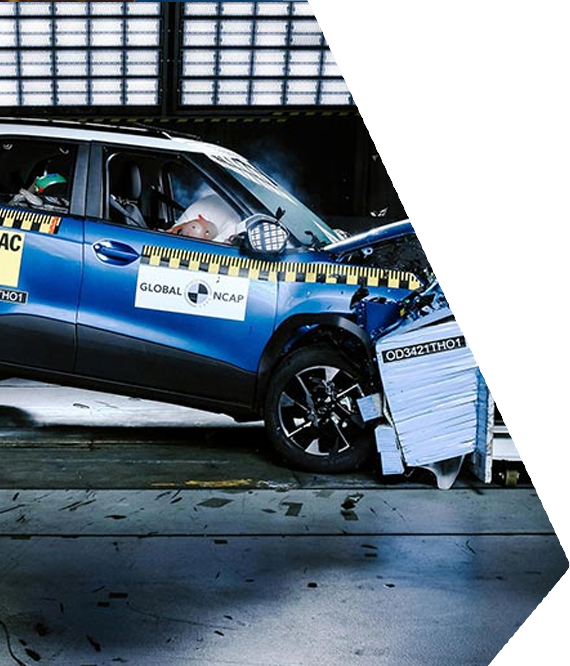
From designing and building the safest vehicles, to running safe operations in our plants and offices, to engaging with our diverse stakeholders, and supporting community causes we espouse.









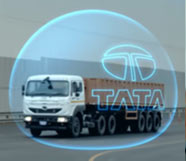
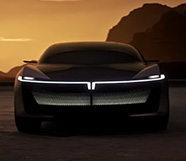
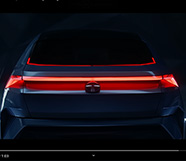

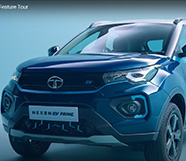

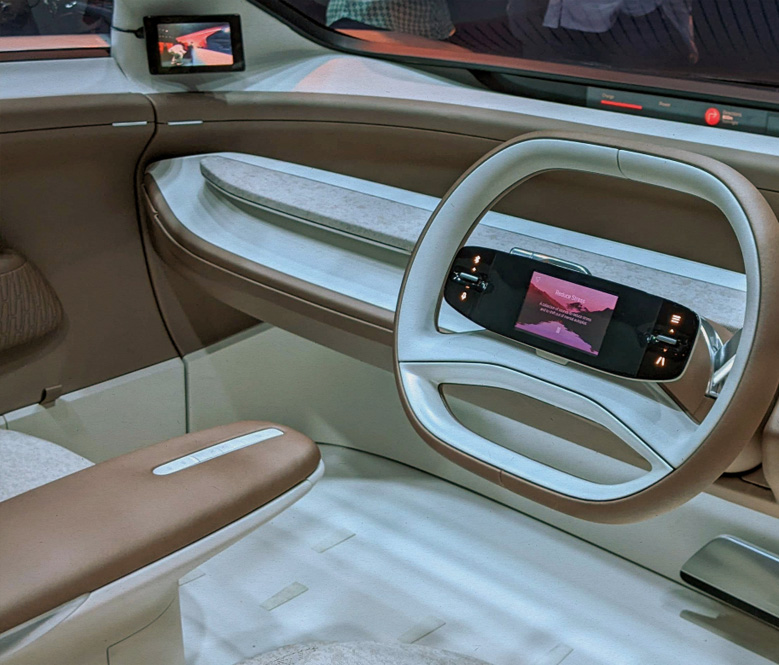
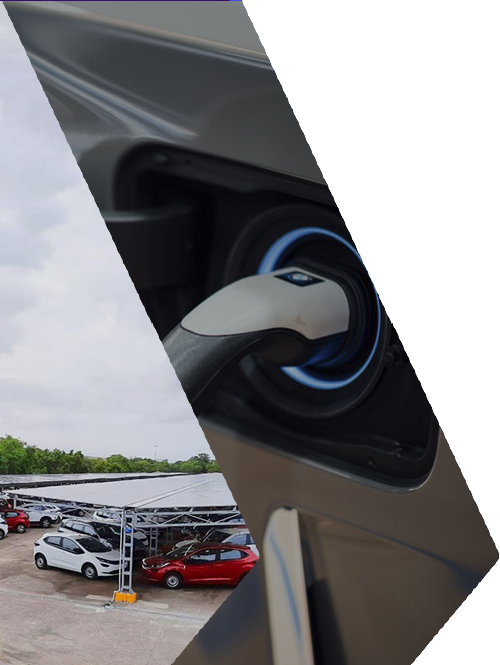
Consuming energy from renewable sources; and reducing tail pipe emissions, we are accelerating the adoption of new age mobility and contributing towards
India's 'net zero' carbon emission goals.


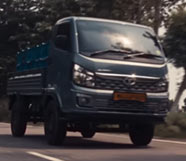


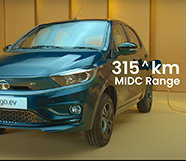

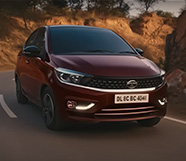
Last year, in the middle of the raging pandemic, Tata Motors (TML) became the only carmaker in India to register sales growth. The revenue from passenger vehicles (PVs) increased by a whopping 106% in FY21. This increase was not only on account of pent-up demand and a refreshed basket of products but also the safety standards and ratings of our vehicles. With TML having taken a significant lead on passenger car safety, customer inclination and interest to buy our products have increased.
In 2018, Tata Nexon became the first designed, developed and made-in-India car to receive a five-star rating from the Global NCAP for adult occupancy safety — an achievement that put India on the global map and became a precursor to TML's active role in advancing vehicle safety. This accomplishment was repeated by the Tata Altroz in 2020, making it the first premium hatchback in the Indian automotive industry to receive a 5-star GNCAP (Global New Car Assessment Programme) rating. More recently, Tata Punch, India's first sub-compact SUV was recognised with a 5-star GNCAP rating. Currently, among the four vehicles to receive a 5-star rating in India, three are from the house of Tata Motors thereby reiterating the company's top priorities while designing and developing cars for its customers. With Tiago and Tigor being accredited with 4-star GNCAP ratings in 2020, TML is well on its way to fulfilling its strategy of "safety is for all and not a privilege for few". The success of Tata cars in repeatedly meeting global crash-test standards isn't something that happened overnight. Not many know that we were the first in India to invest in a crash test facility back in 1997, a year before the launch of the Indica — India's first fully indigenous passenger car.
Crash tests are critical to evaluate vehicle structure behaviour in a crash and bake in necessary design interventions to mitigate injuries and loss of life to vehicle occupants and pedestrians. Its importance can't be overstated in a country like India, where road fatalities take around 1.5 lakh lives every year or 400 in a day. The fact that TML invested in such a facility at a time when there were no such benchmarks in India speaks volumes about Tata's outlook towards car safety.
As an original equipment manufacturer, TML has gone beyond the mere letter of the regulatory framework to address its spirit. The company has stayed ahead of the curve by building a long-term strategic road map and realising it through expert engineering teams, making investments, incubating innovative concepts, choosing the right technology partners, and delivering solutions for mass markets through frugal engineering. As a result, TML not only leads the safety quotient for PVs in India, its GNCAP achievements testify to the fact that Indian car makers can deliver the highest global standards of safety. It now aims to offer the safest car in every segment, making the best in global car safety accessible to Indian customers. Tata Tigor Electric Vehicle (EV), which was launched recently, is the only EV in the country with a GNCAP 4-star rating for both adult and child safety.
Buyers today prioritise safety over factors like speed and mileage before making a purchase decision. Our growth in PV revenue reflects the traction and popularity that we are gaining amongst the Indian car buyer on this front.
Most of our offerings, for years now, come equipped with airbags, seat-belt reminders, alert systems for speed above 80 kmph, reverse parking sensors, manual override over the central locking system for emergencies. We also proactively offer enhanced adult and child occupant protection through class-leading safety features like fortified cabins that absorb impact energy and protect the passenger, tyre pressure monitoring system, side and curtain airbags, ISOFIX anchorages for child safety, etc. This was further elevated in the 2020's New Forever range, which featured best-in-class safety alongside a major upgrade in design, powertrain and technology. And with safety being an important pillar of mobility transformation through CESS (Connected, Electric, Safe, and Shared), the demand for it in India is only poised to grow.
Electronic and software content in vehicles is on the rise, and the move towards EV will further it. In the past few years, we've launched a range of safety-related technologies like Electronic Stability Control, Automatic Traction Control and Hill Start Aid across PVs, EVs and CVs. We continue to invest in R&D facilities and technologies like Advanced Driver Assistance Systems, driver-health monitoring systems, Connected Vehicle Platform features, etc.
We're also betting on the electric mobility industry. Safety has additional dimensions for EVs because of the nature of energy. In a high-ambient-temperature country like India, the safety of battery packs is one such challenge. The presence of high voltage in the vehicles poses another challenge. The different engine bay packaging and addition of battery packs, management of crash energy, and load paths may drive structural changes and lead to innovations.
Overall, TML's EVs are not only at par with internal combustion engine counterparts but also meet the additional requirements mandated for EVs.
The pandemic is now making businesses consider additional safety measures. As the fear of the virus drives people to their own vehicle rather than shared mobility a trend that's likely to continue - we're already looking at features that can mitigate risks associated with the pandemic and enable health and wellness monitoring.
Covid-19 has changed the way of life, and it is now important to think about what current and future customers need differently. If we can achieve that, we will be future-ready.
Last year, in the middle of the raging pandemic, Tata Motors (TML) became the only carmaker in India to register sales growth. The revenue from passenger vehicles (PVs) increased by a whopping 106% in FY21. This increase was not only on account of pent-up demand and a refreshed basket of products but also the safety standards and ratings of our vehicles. With TML having taken a significant lead on passenger car safety, customer inclination and interest to buy our products have increased.
In 2018, Tata Nexon became the first designed, developed and made-in-India car to receive a five-star rating from the Global New Car Assessment Programme (https://www.globalncap.org/) for adult occupancy safety - an achievement that put India on the global map and became a precursor to TML's active role in advancing vehicle safety. This accomplishment was repeated by the Tata Altroz in 2020, making it the first premium hatchback in the Indian automotive industry to receive a 5-star GNCAP (Global New Car Assessment Programme) rating. With Tiago and Tigor receiving 4-star GNCAP ratings in 2020, TML is well on its way to fulfilling its strategy of "safety is for all and not a privilege for few".
The success of Tata cars in repeatedly meeting global crash-test standards isn't something that happened overnight. Not many know that we were the first in India to invest in a crash test facility back in 1997, a year before the launch of the Indica - India's first fully indigenous passenger car.
Crash tests are critical to evaluate vehicle structure behaviour in a crash and bake in necessary design interventions to mitigate injuries and loss of life to vehicle occupants and pedestrians. Its importance can't be overstated in a country like India, where road fatalities take around 1.5 lakh lives every year or 400 in a day. The fact that TML invested in such a facility at a time when there were no such benchmarks in India speaks volumes about Tata's outlook towards car safety.
As an original equipment manufacturer, TML has gone beyond the mere letter of the regulatory framework to address its spirit. The company has stayed ahead of the curve by building a long-term strategic road map and realising it through expert engineering teams, making investments, incubating innovative concepts, choosing the right technology partners, and delivering solutions for mass markets though frugal engineering. As a result, TML not only leads the safety quotient for PVs in India, its GNCAP achievements testify to the fact that Indian car makers can deliver the highest global standards of safety. It now aims to offer the safest car in every segment, making the best in global car safety accessible to Indian customers.
The latest addition is the Tigor Electric Vehicle (EV), which is the only EV in the country with a GNCAP 4-star rating for both adult and child safety.
Buyers today prioritise safety over factors like speed and mileage before making a purchase decision. Our growth in PV revenue reflects the traction and popularity that we are gaining amongst the Indian car buyer on this front.
Most of our offerings, for years now, come equipped with airbags, seat-belt reminders, alert systems for speed above 80 kmph, reverse parking sensors, manual override over the central locking system for emergencies. We also proactively offer enhanced adult and child occupant protection through class-leading safety features like fortified cabins that absorb impact energy and protect the passenger, tyre pressure monitoring system, side and curtain airbags, ISOFIX anchorages for child safety, etc. This was further elevated in the 2020's New Forever range, which featured best-in-class safety alongside a major upgrade in design, powertrain and technology. And with safety being an important pillar of mobility transformation through CESS (Connected, Electric, Safe, and Shared), the demand for it in India is only poised to grow.
Electronic and software content in vehicles is on the rise, and the move towards EV will further it. In the past few years, we've launched a range of safety-related technologies like Electronic Stability Control, Automatic Traction Control and Hill Start Aid across PVs, EVs and CVs. We continue to invest in R&D facilities and technologies like Advanced Driver Assistance Systems, driver-health monitoring systems, Connected Vehicle Platform features, etc.
We're also betting on the electric mobility industry. Safety has additional dimensions for EVs because of the nature of energy. In a high-ambient-temperature country like India, the safety of battery packs is one such challenge. The presence of high voltage in the vehicles poses another challenge. The different engine bay packaging and addition of battery packs, management of crash energy, and load paths may drive structural changes and lead to innovations.
Overall, TML's EVs are not only at par with internal combustion engine counterparts but also meet the additional requirements mandated for EVs.
The pandemic is now making businesses consider additional safety measures. As the fear of the virus drives people to their own vehicle rather than shared mobility - a trend that's likely to continue - we're already looking at features that can mitigate risks associated with the pandemic and enable health and wellness monitoring.
Covid-19 has changed the way of life, and it is now important to think about what current and future customers need differently. If we can achieve that, we will be future ready.
Propelled by the global thrust towards sustainability and carbon neutrality, industry leaders and governments have joined hands to build a world that is less reliant on carbon and powered by clean fuel sources. Leading from the front, the Government of India has committed to reducing the emissions intensity of its GDP by 45 percent by 2030 from its 2005 levels. Being a prime sector that drives the wheels of our economy and bears a significant impact on energy consumption, the automotive industry has specifically planned and implemented tangible changes and contributed to the fulfilment of the national targets.
Government incentives and rising consumer demands have accelerated the move toward electrification, with India's electric vehicle market showcasing a projected growth rate of 49 percent between 2021-30. While this enthusiastic uptake of electric technology is exciting, it is also important for leading OEMs to stay abreast of the emergence and furthered penetration of alternate fuel technologies that supplement the move towards zero-emission transportation. Hydrogen being a prominent energy carrier, in particular, offers intriguing possibilities.
Hydrogen-enriched compressed natural gas (HCNG) is a blend of a small quantity of hydrogen (up to 18 percent) and CNG that has sparked interest as a relatively low-emission fuel option. It lowers fuel consumption and enhances thermal efficiency while reducing carbon monoxide emissions significantly when compared to CNG.
To test its benefits, the Delhi government launched a pilot project in 2020 with 50 HCNG buses in the capital. This came after the Supreme Court's advice on exploring fuel options that could reduce emissions and help tackle air pollution. While the study has not yielded conclusively positive results yet, the potential of HCNG is something worth considering. Initial results suggest that considerations such as the mixing of hydrogen at the source, the percentage of the blend and appropriate capital investments will be important to help scale up such a model.
While the EV market currently is dominated by battery-electric vehicles (BEVs), hydrogen can play an important role by powering fuel-cell EVs (FCEVs). Fuel cell technology relies on hydrogen’s chemical energy to produce electricity cleanly and effectively. FCEVs use a stored hydrogen-powered cell stack, instead of batteries to power vehicles. This effectively makes them amongst the cleanest modes of transportation, with no harmful tailpipe emissions, emitting only water vapour and warm air.
FCEVs will be pivotal in the electric future precisely because they possess higher energy density and require shorter fueling time which is a necessity for long-range applications. They can help to do away with range anxiety within customers if developed and offered as optimal solutions. They are inherently renewable and environment-friendly and future technical enhancements can improve the overall well-to-wheel efficiency for FCEVs, pegged at 30-35 percent today. Amidst a growing electric market that is only going to become more diverse and sophisticated over the second half of this decade, one can expect FCEVs to assert their presence as a strong complement to pure BEVs.
While the two potential uses of hydrogen discussed are undergoing a fair amount of development in the current era, one technology that is still in its infancy but could exert a revolutionary impact is the combustion of pure Hydrogen using IC Engines. FCEVs and BEVs, despite impressive developments, have limitations to deliver the specific high-power and duty cycle needs of heavy-duty commercial vehicles. For example, long-haul trucks and tippers operate under challenging conditions, running round-the-clock and consuming huge amounts of power.
Internal combustion engines (ICEs) have effectively catered to these demands for years. Swapping diesel for hydrogen in ICEs can be an efficient way of decarbonizing engines. Of course, further research and development is a necessity on this front, especially to tackle the inherently high combustibility of hydrogen and to leverage the potential in a controlled manner. However, existing research suggests that hydrogen combustion can be an effective way of helping remove carbon dependency in heavy-use transportation. It would also require lesser technical interventions and could continue to rely on existing engineering know-how.
Achieving the zero-emissions target is a challenging goal for the automotive sector, one it is striving to meet in earnest, with efforts from all directions. Investing time and effort in developing hydrogen technology, whether in the form of the transitional HCNG, the promising FCEV or the revolutionary hydrogen combustion engine can together yield promising results. Government support, with initiatives such as the National Hydrogen Energy Mission Programme, combined with the collective faculties of leading players in the industry will play an instrumental role in ushering in a clean and green era of mobility.
The writer is president and CTO of Tata Motors.
The thoughts and opinions shared here are of the author.
Road accidents account for one of the leading causes of death in the world[1] claiming nearly 1.3 million lives each year. India itself accounts for 11% of global death in road accidents[2]. Hence road safety and its awareness become a critical issue for the prevention of accidents. The Government of India is focusing on 4Es of road safety, namely Engineering, Education, Enforcement, and Emergency Care. The United Nations, in its Decade of Action for Road Safety 2021-2030, has set an ambitious target of preventing at least 50% of road traffic deaths and injuries by 2030.
Our roads can be made safer by deploying updated regulations as well as innovative interventions by OEMs/automobile companies who constantly work on enhancing the safety of their products by making sustainable investments in accident research. Continuous research is imperative to come up with technologies and design of safer products or safety features in products. Tata Motors has been one of the early movers in the automobile industry with respect to making investments for establishing state-of-the-art digital and physical product development processes manned by the best minds in terms of road safety in the country. The endeavour to build a safe vehicle is a complex and meticulous process that requires constant coordination between multiple parties. Here we demystify some of the crucial steps for making safer vehicles for tomorrow.
Contrary to common perception, vehicular safety is much more than just 'airbags'. It is all-encompassing and has numerous aspects covering the vehicle, the environment and the people who drive the vehicle in three stages: namely, pre-, during- and post- an accident. This also means that safety is not only passive but also active. Passive safety covers devices that operate when an accident occurs. Seat belts, front, side and curtain airbags, head restraints, ISOFIX mounts, etc. are some examples of such devices. In contrast, active safety encompasses all other features that promote safe driving, such as the presence of brake assists, tyre pressure monitoring sensors, parking sensors, etc. In fact, several advanced driver-assist features embed safety holistically and aid in preventing accidents and post-crash situations as well. The integration between active and passive safety is crucial in building a safer vehicle.
Besides incorporating vehicular features to enhance safety, safety professionals must also keep in mind the specificities of human anatomy, understanding how men, women, and children respond to various contact and non-contact injuries caused by accidents. In addition, they must factor in several real-world safety challenges drivers face, computing a fair share of potential cases of accidents that people can be protected against. However, there exist limitations that must be taken into account.
Once a vehicle is on the road there are innumerable real-world safety challenges every driver constantly encounters, from frontal or offset crashes, to side hits, rear-end collisions, roll-overs, and instability. The complexity of mass and human anatomy and driving on improper roads at varying and sometimes breakneck speeds, all pose fundamental challenges of appropriate product configuration for maximising protection in extraordinary circumstances when needed by either the vehicle occupant or the pedestrian.
Taking account of these use-cases in part, as mentioned earlier, is important to ensure safety. However, providing for each of them will make automobiles so unaffordable that a safety-conscious prospective buyer will have to settle for affordable mobility solutions which are unfortunately unsafe. Inappropriate configuration and over-specification of products can therefore become a case of the "great" becoming the enemy of the "good". Thus, it is important to research accidents and cluster them wisely to carefully configure learnings in products. Automakers must provide safe options for customers in non-luxury products too, while striving to democratise safety for all.
To effectively judge the safety of their vehicles, automakers often sign up for third-party independent protocols, developing products to meet them religiously. This provides vehicles with performance (star) ratings based on rigorous independent digital analysis and robust physical testing. Auto developers must work in coordination with various stakeholders to ensure good performance. In essence, the star-rating a car gets, such as those provided by GNCAP, signifies the probability of injury in the car. Thus, a car with a 5-star rating significantly reduces the probability of a life-threatening injury as compared to that with a 1-star rating.
As one can imagine, to meet these exacting standards, a vehicle must undergo strict testing under very challenging circumstances. Biofidelic dummies are calibrated before each crash test, and months, if not years of component and sled-testing are conducted to ensure that the results align with the outcomes expected. This development journey requires a great understanding of safety protocols, including guidelines for evacuation of passengers trapped inside the vehicle post-accidents. These are the types of challenges that motivate Safety professionals and manufacturing engineers to engage in a lifetime of pursuit of excellence so that our products deliver high quality safety.
As is evident, the process of producing a safe vehicle requires unmatched skill, patience, and research. At its heart is years of accident research and analysis done by hundreds of safety professionals, labs, government agencies, and NGOs. Yet, more than anything else, vehicle safety is an evolving science. With changing road landscapes and newer vehicles, the endeavour towards making safer vehicles is constantly in progress, in pursuit of building a safer tomorrow.
In closing, I would urge you to embrace a simple old advice that espouses the cause of safety… Read in Marathi it states "The Brake on the mind is the best brake". Spending a few minutes on "thinking" safety before start of any journey and constantly reminding ourselves of safety, as we journey through life, is as vital as the outstanding computing algorithms and devices that our vehicles are constantly working with, for ensuring our safety.
With increasing occurrences of accidents and road fatalities globally and in India, safety has become a significant consideration for automotive manufacturers and customers alike. Its importance can't be overstated in a country like India, where road fatalities take around 1.5 lakh lives every year or 400 in a day. Therefore, with safety being an important pillar of mobility transformation through CESS (Connected, Electric, Safe, and Shared), the demand for it in India is only poised to grow. As a leading player in the Indian automotive industry, Tata Motors continues to emphasize its core commitment to delivering the safest vehicles in every segment.
Commenting on the continued emphasis on enhanced safety standards, Mr. Rajendra Petkar, President & CTO, Tata Motors said, "Buyers today have started to look beyond traditional attributes like economy & performance, and they prioritise safety before making a purchase decision. Our growth in PV revenue reflects the traction and popularity that we are gaining amongst the Indian car buyers on this front. We have stayed ahead of the curve by building a long-term strategic road map for safety, and have realized it through expert engineering teams, making investments, incubating innovative concepts, choosing the right technology partners, and delivering solutions for mass markets through frugal engineering. Our GNCAP achievements are a testament to our firm commitment towards offering products that can deliver the highest global standards of safety. As we turn towards a new chapter of transformation in the automotive sector, we are confident that Tata Motors will maintain its lead on passenger car safety and remain the preferred choice of customers for years to come."
Evolving needs, changing social priorities and economic circumstances have consistently determined the nature of mobility across the world. Passenger vehicle styles have undergone consistent transformation over the years in tandem with varying geographical requirements and customer needs. In the past decade, sports utility vehicles (SUVs) have increasingly made their presence felt within the market, seeing marked increase in adoption. Between 2010 to 2021, the global population of SUVs has increased from fifty million to a whopping 320 million.
India too, has seen considerable increase in the adoption of SUVs. In the last three years alone, the SUV share in India increased from about 23% in FY19 to about 41 % in FY22. So, why are SUVs becoming increasingly popular in India, and what are some key defining features that determine the SUV preference today?
For starters, the way SUVs are perceived has shifted considerably. Utility vehicles were initially conceived as hard-wearing, utilitarian workhorses with an emphasis on enclosed utility. They were purpose-built, high on capability and meant for off-road usage (for use in challenging terrain, like sand, mud, rocks, in the absence of paved road). But today, SUVs are increasingly becoming lifestyle-defined, high on practicality, and meant for urban usage with on-road capability (the ability of a vehicle to drive at high speeds on highways and in ghats with good stability).
Within India particularly, both practical and aspirational/emotional considerations are driving demand for SUVs within customers. SUVs offer a significant advantage on Indian roads, providing optimum navigation with high ground clearance on broken tarmac and speed breakers. On flooded roads during the rainy season, their increased ride height and command seating position allows for more confident driving, and Indian customers generally feel safer in an SUV in typical Indian driving conditions. Besides this, SUVs also come with a strong aspirational value, with the promise of fun and adventure fuelled by their go-anywhere capability.
Utility vehicles of the past essentially just came with seats on a chassis, offering comfort which was just a little better than riding horseback. Compare that to SUVs today, which offer unparalleled ride and seating comfort. Modern SUVs are comfortable to drive and ride in, ergonomically designed to provide enhanced ride and seating comfort. They also include advanced features for temperature control.
Further, SUVs before typically connoted big, large, and bulky. This was in tandem with their view as mostly utility-based vehicles. However, with changing customer demands, SUVs have evolved considerably. SUV design elements on small but capable products have largely democratised the SUV lifestyle. Consequently, SUVs today come in all sizes. Just as in the case of cars, they are categorized as sub-compact, compact, and full-size. Their design aptly symbolizes the stylized, sturdy and confident, and irrespective of the size they come in, they deliver uncompromisingly on expected performance.
Since SUVs initially were built to tackle challenging terrain, the focus was mainly on offering good low-end torque. These vehicles were not ideal to drive on roads or highways. Modern SUVs, however, have a considerably better spread of high performance and capability, both at low and high speeds. The downsized petrol and diesel engines and EV powertrains help provide adequate performance across speed range.
Combined with this promising performance is the augmented safety SUVs offer both on and off roads. Safety has gained increasing traction from Indian customers, and it is no surprise that SUVs are incorporating heightened safety features to deliver on this front. They offer improved structural safety with features which enhance crash avoidance like anti-lock braking systems (ABS) and electronic stability programs (ESP). Additionally, multiple airbags offer in-crash protection, with advanced safety features like advanced driver assist systems (ADAS) and post-crash assistance in the form of auto-emergency calls.
Besides, like all future-ready vehicles, SUVs today come equipped with modern technology elements, tying together connectivity and convenience and safety to provide for an elevated driving experience.
The reason SUVs are fast emerging as the category of choice in India is because they bring together a very wide arena of benefits. They project confidence and stature and are a style statement, but also offer unmatched comfort, superior performance, flexibility in size, and enhanced safety. With changing lifestyles and priorities, it seems India is eagerly marching towards making SUVs the norm. Now is a time like no other to ride on the crest of this transformation, bringing forth elevated offerings within the segment that not only delivers on existing customer expectations, but also takes it a step further in surprising them.
Road accidents account for one of the leading causes of death in the world claiming nearly 1.3 million lives each year. India itself accounts for 11 percent of global death in road accidents. Hence road safety and its awareness become a critical issue for the prevention of accidents. The Government of India is focusing on 4Es of road safety, namely Engineering, Education, Enforcement, and Emergency Care. The United Nations, in its Decade of Action for Road Safety 2021-2030, has set an ambitious target of preventing at least 50 percent of road traffic deaths and injuries by 2030.
Our roads can be made safer by deploying updated regulations as well as innovative interventions by OEMs/automobile companies who constantly work on enhancing the safety of their products by making sustainable investments in accident research. Continuous research is imperative to come up with technologies and design of safer products or safety features in products. Tata Motors has been one of the early movers in the automobile industry with respect to making investments for establishing state-of-the-art digital and physical product development processes manned by the best minds in terms of road safety in the country. The endeavour to build a safe vehicle is a complex and meticulous process that requires constant coordination between multiple parties. Here we demystify some of the crucial steps for making safer vehicles for tomorrow.
Contrary to common perception, vehicular safety is much more than just 'airbags'. It is all-encompassing and has numerous aspects covering the vehicle, the environment and the people who drive the vehicle in three stages: namely, pre-, during- and post- an accident. This also means that safety is not only passive but also active. Passive safety covers devices that operate when an accident occurs. Seat belts, front, side and curtain airbags, head restraints, ISOFIX mounts, etc. are some examples of such devices. In contrast, active safety encompasses all other features that promote safe driving, such as the presence of brake assists, tyre pressure monitoring sensors, parking sensors, etc. In fact, several advanced driver-assist features embed safety holistically and aid in preventing accidents and post-crash situations as well. The integration between active and passive safety is crucial in building a safer vehicle.
Besides incorporating vehicular features to enhance safety, safety professionals must also keep in mind the specificities of human anatomy, understanding how men, women, and children respond to various contact and non-contact injuries caused by accidents. In addition, they must factor in several real-world safety challenges drivers face, computing a fair share of potential cases of accidents that people can be protected against. However, there exist limitations that must be taken into account.
Once a vehicle is on the road there are innumerable real-world safety challenges every driver constantly encounters, from frontal or offset crashes, to side hits, rear-end collisions, roll-overs, and instability. The complexity of mass and human anatomy and driving on improper roads at varying and sometimes breakneck speeds, all pose fundamental challenges of appropriate product configuration for maximising protection in extraordinary circumstances when needed by either the vehicle occupant or the pedestrian.
Taking account of these use-cases in part, as mentioned earlier, is important to ensure safety. However, providing for each of them will make automobiles so unaffordable that a safety-conscious prospective buyer will have to settle for affordable mobility solutions which are unfortunately unsafe. Inappropriate configuration and over-specification of products can therefore become a case of the "great" becoming the enemy of the "good". Thus, it is important to research accidents and cluster them wisely to carefully configure learnings in products. Automakers must provide safe options for customers in non-luxury products too, while striving to democratise safety for all.
To effectively judge the safety of their vehicles, automakers often sign up for third-party independent protocols, developing products to meet them religiously. This provides vehicles with performance (star) ratings based on rigorous independent digital analysis and robust physical testing. Auto developers must work in coordination with various stakeholders to ensure good performance. In essence, the star-rating a car gets, such as those provided by GNCAP, signifies the probability of injury in the car. Thus, a car with a 5-star rating significantly reduces the probability of a life-threatening injury as compared to that with a 1-star rating.
As one can imagine, to meet these exacting standards, a vehicle must undergo strict testing under very challenging circumstances. Biofidelic dummies are calibrated before each crash test, and months, if not years of component and sled-testing are conducted to ensure that the results align with the outcomes expected. This development journey requires a great understanding of safety protocols, including guidelines for evacuation of passengers trapped inside the vehicle post-accidents. These are the types of challenges that motivate Safety professionals and manufacturing engineers to engage in a lifetime of pursuit of excellence so that our products deliver high quality safety.
As is evident, the process of producing a safe vehicle requires unmatched skill, patience, and research. At its heart is years of accident research and analysis done by hundreds of safety professionals, labs, government agencies, and NGOs. Yet, more than anything else, vehicle safety is an evolving science. With changing road landscapes and newer vehicles, the endeavour towards making safer vehicles is constantly in progress, in pursuit of building a safer tomorrow.
In closing, I would urge you to embrace a simple old advice that espouses the cause of safety. translated from the Marathi it reads as "The Brake on the mind is the best brake". Spending a few minutes on "thinking" safety before start of any journey and constantly reminding ourselves of safety, as we journey through life, is as vital as the outstanding computing algorithms and devices that our vehicles are constantly working with, for ensuring our safety.
The impact of the Covid-19 pandemic on supply chains world-over has been profoundly disruptive, to say the least. Reeling under sudden lockdowns, fluctuations in demand and supply, logistics disruptions and shortages, the automotive industry was left in the deep end for over a year and is still recovering from the shock. Global semiconductor shortages continue to haunt the automotive industry even today. What the pandemic has taught us, above all else, is the need to entirely rethink our strategic objectives when it comes to supply chains.
Prior to the pandemic, most supply chains were focused on cost-optimization and throughput - the priority was to source parts at the lowest cost as quickly as possible. We weren't really thinking about flexibility or business continuity plans, or wondering, what if customer demands shift dramatically overnight? But post Covid-19, these questions have become central to supply chain management. As we venture into the future and plan for 2022 and beyond, it is time to reimagine our supply chain strategies to be FutuReady.
On a primary level, it is critical to ensure the supply chains we build function well according to some basic parameters. It is necessary, for instance, that we have complete visibility of our overall supply chain. We must view it across tiers, keeping in mind customer demands, technicalities of the procurement of raw materials, semi-finished goods, or components that go into our finished goods. The further we can go down and into the supply chain, the more effective we're going to be at planning our supply chain. Closely understanding manufacturing and warehouse processes, logistics, shipping, and third-party logistics can also present optimization opportunities. Further, a solid understanding of the cost structure at a unit level is very important to prevent sudden supplier breakdowns and can help organizations keep costs under check while maintaining steady margins, even allowing them to leverage supplier clusters to minimize cost.
Besides this, it is also necessary to diversify the supplier base. It is important that you ensure you have a plan B, a plan C, and backup vendors in case one vendor cannot meet your needs. This may reduce purchasing power with any one given supplier, but that might be a worthy trade-off while gaining flexibility, dependency, and reliability within your supply chain. Your existing suppliers must also be reliable. When determining supplier reliability, make sure you consider some questions like: Is it likely our suppliers will have to shut down or not run-in full capacity during a tumultuous time? Are they proactively collaborating with their supply chain on changes in demand, capacity requirements and other critical factors? Are they adequately staffed?
Once we have addressed our basics, we can optimize the supply chain in several ways. Consider for instance, ways in which you can simplify products and standardize parts. Overly complex products involving a large variety of materials makes the supply chain complex and prone to disruptions. Instead, procuring standard catalogue rather than product-specific parts can help maintain a lean supplier base - case in point: an application specific integrated circuit in the semiconductor industry. Another way to have a minimum disruption supply chain is optimizing logistics. Procuring parts locally instead of obtaining them across the globe can help mitigate geo-political risks.
Demand and supply planning can also be critical in enhancing efficiency in the supply chain. Companies that can align demand with supply gain an edge when compared with the rest. Since this delicate balance starts with the proactive management of demand, demand planning and forecasting acquires critical priority. Aligning with your customers' needs improves the customer experience, accelerates cash flow and brings profit to the bottom line. To understand demand fluctuations, keeping an ear to the ground and getting in touch with stakeholders (customers, sales staff and customer service representatives) can be fruitful. On the supply front, it is important to ensure capacity readiness, and retain agility and flexibility while delivering consistently as per demand.
On a broader level, it is also important that we learn to manage risks proactively, rather than reactively. While it is certainly impossible to predict black swan events like the pandemic, one can remain acutely aware of one's own vulnerabilities, especially vis-à-vis pressure areas in the supply chain. Instituting a comprehensive business continuity plan can prove invaluable in this regard, giving companies a systematic framework to anticipate risks and work towards mitigation. The moment risk is sensed from any sector, this BCP must be set in motion. This can play a crucial role in allowing the OEM to insure itself against long-term damage.
Ultimately, the supply chain networks of the future must incorporate the larger values of our transforming world. Advancement in online connectivity and digital technology has made itself apparent and has promising potential to revolutionize the functioning of supply chains. Digital tools (a supply chain control tower) can provide real-time data, predict trends, provide early warning signals, and closely track supply performance. At the same time, we must also remain in alignment with the global move towards sustainability. Supply chains must build roadmaps for achieving net zero emissions, water neutrality and full recyclability of materials in the next few decades.
Going forward, we must strive to build an agile, productive, resilient, digital and sustainable supply chain, driven by strategic business continuity plans and proactive risk management at the core.
Disclaimer: Views and opinions expressed in this article are solely those of the original author and do not represent any of The Times Group or its employees.
With the industry at large at the cusp of a new era of mobility driven by electrification, connectivity and sustainability, exciting opportunities await manufacturers and customers alike. The migration to this not-so-distant future, driven by advanced technology and alternate fuel, represents something larger for the automotive sector.
In tandem with all the innovation and groundbreaking thinking that will underscore the functioning and performance of the vehicles of tomorrow, one must also re-envision the ways in which they are crafted, and the experiences they offer. In other words, we must prepare ourselves to design for the future, adopting a progressive design ideology that is humane, simple and aspirational.
The core axis along which the design of cars must revolve around today is the user. Customers view their cars as objects that represent a particular way of life, and everything within the car, right from its very design, must affirm this belief. Since the migration to electric is a momentous one, a sense of anxiety persists within customers, not only regarding performance features and range but also about how reliable it will be overall. They look for a sense of validation in the experience they have with the car. Thus, every aspect of their experience— how they open the door, how they sit, how they drive, should come with an undertone of serenity and comfort, diffusing any stress.
The interiors of a next-generation car should foster a similar ethos. Striving to build almost a sanctuary within the car, we must make use of the philosophy of the five senses to help take the experiences of drivers and passengers alike to the next level. Besides being spacious and class-leading, the interiors should also generate a visual feel of space that is larger-than-life and rich, without being too pompous or loud.
Embracing a minimalist, simple approach then, is critical to take consumer expectations to the next level. Sleek exteriors, that convey space without looking bulky, can go a long way in reflecting sophistication. This can also be done in a tactful manner to marry the benefits of practical comfort with cutting-edge design. In the Tata Avinya concept car, for instance, we have created a secondary silhouette, extending the front windscreen forward that gives the car an elongated appearance while having conventional proportions.
Technology of course, is a critical aspect of the design rhetoric. Any design that concretizes itself as iconic, whether it be of a furniture or a consumer electronic, does so because it brings with it a certain advancement in technology. The onset of electric vehicles represents one of the most critical advancements within the automotive sector and their design must convey this. Its proportions and interior layout must effectively envelop its technological offerings. Here too, the 'less is more' philosophy can work in meaningful ways.
An example might help explicate this further. Currently, the industry tendency is focused on imbuing modern cars with excessively screened interiors, often end-to-end, to provide a host of tech tools. With Tata's Avinya, we have attempted to moderate this tendency by altering this screen experience.
We only have a small screen on the steering to help perform primary functions, and a long one at the base of the windscreen to provide secondary information such as temperature, range and infotainment. This minimal design intervention is complemented through the main interface in the car for human-machine interaction- which is not through a touchscreen but a sound bar. Herein lies the convergence of human-centric design and simplicity, that strives to bring to users the advanced technology in a mode that is harmonious and pleasant.
Good design is all about being simple. And it is this simple recipe that is repeated, on the exteriors of a car, on its interiors, its broad surfaces, and its little details. When designing a vehicle, it is imperative that we start with its overall functionality for people. Aesthetics and styling come after that. The purity of design should come from the way a user utilizes the product. Vehicles should have a long life, and their design must represent the ethos of timelessness while incorporating contemporary advancements. Minimalistic design, in this context, is the best way forward, because it imbues vehicles with a certain elegance while incorporating functionality in a tactical way.
Customers, after all, should know exactly what a product offers by looking at it. It should be memorable, it should be customer-first and it should imbibe a concrete sense of functional value; and with that simple recipe you should have a car that is inspiring, modern and a class apart, a befitting part of a unique future generation.
Disclaimer: Views and opinions expressed in this article are solely those of the original author and do not represent any of The Times Group or its employees.
The past few years have been, in many ways, paradigm-shifting for the automotive industry. The post-pandemic reality, coupled with the move towards sustainable, connected, technology-driven mobility has left a lasting impression on customer expectations. While this transition from one ecosystem to another has been replete with its own challenges, leading OEMs within the industry have showcased immense resilience, effectively turning difficulties into opportunities.
Leaders within the Indian automotive sector, in particular, have an exciting and challenging road ahead in converting this long-standing resilience into resounding success. Against a rapidly changing industry landscape, re-envisioning our core strategies with regard to mobility will be critical in defining our trajectory for the future.
Indian customers have become increasingly aware of the risks that arise from road accidents. Thus, safety has emerged as an important factor when buying cars. Exposure to international markets and unlimited access to information have empowered customers to choose safer cars. Along with wanting safer cars that have undergone crash tests certified by independent bodies, customers have started valuing the inherent structural safety of cars as well. Three-fourths of Indian consumers, according to a survey, said they were willing to extend their budget for safety considerations and preferred to explore four or five-star-rated safety vehicles for future purchases.
This clearly demonstrates that safety should be of paramount importance for OEMs while manufacturing vehicles. Investing where it matters most and placing customer safety at the centre of all our endeavours, will be critical in developing a portfolio that resonates with consumers. This entails covering the basics of passive (such as adjustable seat belts, airbags, rear head restraints, isofix mounts, etc.) as well as active safety features (such as brake assists, tyre pressure monitoring sensors, parking sensors, etc). Further, it will also be worthwhile to spend time and resources researching how advanced technologies can be employed to take safety to the next level, particularly with assistance intelligence (AI) and other digital tools.
Further, the growth of the passenger car market has led to customers discovering new use cases. This in turn has resulted in the development of vehicles with new body styles, sizes and functionalities. The SUV segment is a great example of how growth has led to fragmentation, with the emergence of a variety of sub-styles such as sub-compact SUVs, compact SUVs with high ground clearance, adventure segments etc. This diversification of market segments in terms of body sizes and styles is expected to continue. OEMs are consequently expanding their portfolios with diverse offerings, developing novel products with contemporary design touches and advanced technology. To drive customer curiosity and effectively leverage their aspirational goals, companies are redefining the way their products are developed and marketed.
Digital consumers are demanding personalized and delightful customer experiences. The transition to digital has been underway for a few years now, but it has accelerated significantly during the pandemic. The automobile industry has been adapting to and addressing these changes proactively and offering innovative solutions that are customer-centric and easy to use. The definition of what comprises a good customer 'experience' has also changed over time, and today not only includes driving experience but also purchase and ownership experience. In addition to providing competitive offerings with advanced features, enhanced safety, and contemporary designs then, companies must also continue to provide a sustained focus on strengthening customer relationships. A fruitful customer relationship will help us stay in touch with changing sentiments while establishing a necessary network of feedback and improvement. Further, building resilient impressions on customers can also help propel product popularity through word-of-mouth communication.
Establishing such a relationship will remain reliant on strengthening all fronts and striving to take customer engagement to new heights. Focusing on providing customers with a smooth ownership experience and seamless service assistance will be critical in creating positive relationships. This can entail expanding accessibility to service centres, being available digitally, providing smooth car delivery experiences, and ensuring shorter repair durations. Improvements on all these fronts, plus the establishment of a strong after-sales service system will be critical for the years to come
Traditionally, the auto industry has had model upgrade cycles spanning six years, with three-year mid-cycle enhancements. But today, customers are demanding changes at a far quicker rate, intimating us to alter traditional timelines. Customer demographics have transformed, and there has been an evolution in their preferences. OEMs are witnessing an influx of younger customers in showrooms, who view cars as aspirational products— with sophisticated technologies, futuristic designs and a series of personalization options.
Thus, cars today, in the mind of consumers, must come not only with the benefits of enhanced performance and safety but also sophisticated designs and accommodative features that allow sufficient personalization. As per this significant shift in perception, the way passenger vehicles are created and pitched has also undergone a transformation.
With leading studies showing promising results for electric cars reducing end-to-end emissions, EVs are expected to become the default choice of sustainable transport for both, personal and commercial mobility needs. Further development in sustainable sources of power will further enhance this trend. OEMs are understandably betting big on the green mobility wave, focusing on engineering sustainable design philosophies that are timeless, promote wellness, and increase the overall quality of life. They are showcasing aspirational products as 'concepts' with a futuristic design language, accentuating aerodynamics and appealing to discerning customers.
We must make the best of our challenges while continuing to place our customers at the very centre of all our efforts. By harnessing our learnings from past experiences, and transforming roadblocks into breakthroughs, we must forge the path leading to a new millennium of e-mobility.
The steady sophistication of digital and connected technology has changed industry landscapes across the globe. Most, if not all, major sectors have tapped into its myriad benefits to strengthen their functioning. This, of course, has been accelerated with the onset of the pandemic, which forced us to adopt digitization at a much faster rate. The way consumers experience things has changed significantly since then, and the virtual mode has become a critical platform of interaction.
Today, most sectors, automotive included, value the potential of technology in dispensing contactless services, driving virtual consumerism and enhancing customer engagement. Yet, for the auto sector, in-person experiences continue to be important. Customers still want to experience their potential cars, gauge the touch, feel and drivability it offers. The art of delivering next-level customer experiences lies in marrying the benefits of both, the physical and the digital worlds, by tapping into the potential of the 'phygital.'
Digitization has indeed become an important component of driving sales. According to a recent study, nearly 14% of the sales of leading auto dealerships were digitally influenced in FY21. Both buyers and retailers have outgrown generic platforms, and now seek evolved, holistic forums of buying. This has led to the steady development of highly nuanced digital platforms, such as Tata Motors' 'Click to Drive', that incorporate the interactive elements we usually find in in-store experiences. Buyers today can discover products from home, with 3-D renditions of car models that help them look at the interiors and exteriors of a car. Some platforms even allow them to customize and design their car through gamified modules. Customers can also seamlessly execute the entire sales process online.
Product specifications no longer need to be curated and compiled into paper catalogues; they can be adapted into crisp, informative video brochures that helps customers remain more engaged. Designated mobile apps connect the dealer sales team and customer, helping present a customized sales experience, complete with insights, follow-up dates, specific requirements, etc. Besides this, the sales team is also looped in this process to provide necessary marketing support through popular channels such as Telegram and WhatsApp.
While leveraging the benefits of the virtual platform and trying to replicate the productive elements of the physical buying experience is important, it is equally important to bring in the virtual to enhance the real as well. The automotive sector is ultimately driven by consumer needs and aspirations, and we must always strive to nurture the relationships we share with every consumer.
Providing customers with a responsive service experience is key. Digital customer service tools can be utilised deftly to convey empathy and foster interpersonal interaction. Remaining in touch in a meaningful manner, providing ready access to sales, services and support is critical to provide an all-encompassing satisfactory experience. An app like the Tata Motors Service Connect (TMSC) seeks to do precisely this.
Further, remaining conscious of safety concerns is also important. The provision of delivering completely sanitized, 'untouched' vehicles has helped allay safety concerns while effectively leveraging the benefit of 'contactless' experiences. In the same way, the concept of 'home test drives' has also become common in order to allow customers to experience their cars physically while enabling social distancing.
A broad hyperlocal vision must inform our brick-and-click approach. This would entail filtering down the benefits of digital tools and platforms right down to the local level. Helping dealers create their websites and social media pages can help enhance their online visibility, resulting in enhanced customer acquisition and engagement. This hyperlocal approach has reaped immense benefits for Tata Motors, which has been deployed across 90% of our nationwide network to create a connected smart digital ecosystem. A sizable amount of 2 lakh customers is being sourced through this approach.
Clearly then, the brick-and-click module offers immense benefits across various stages of the car buying and owning process. For customers, it can bring convenience and cutting-edge technology at their fingertips while fulfilling their want for the touch-and-feel of cars. For dealerships, it can help augment customer bases and elevate customer relationships through consistent connection. And finally, for OEMs as a whole, it can help build a thriving, symbiotic system of functioning that helps cultivate meaningful customer relationships and foster sustainable growth.
With the push towards alternate modes of mobility becoming stronger than ever, the automotive sector at large has sought to look towards reliable options for cleaner fuels. While electric vehicles are on the definitive path of becoming dominant modes of passenger transport in near future, relatively cleaner fuel options like compressed natural gas (CNG) can help supplement the drive of controlling emissions.
Globally, India comprises a sizable chunk of the CNG market, and demand for natural gas has increased substantially over the past decade. Maharashtra, Gujarat, Uttar Pradesh, Haryana, and Delhi account for nearly 85% of the CNG passenger vehicles (PVs) offered in India[] led by Tier 1 cities. Tier-II cities are also showing rising inclinations towards CNG-powered vehicles, primarily due to the reduced total cost of ownership they offer. The rising absorption of CNG is expected to follow CNG pipeline network proliferation planned by the government of India with availability being extended from 7% geographical coverage in 2015 City Gas Distribution (CGD) network bidding to 86% coverage (~600 districts in 28 states and Union territories) in the 2022 CGD bidding. The dispelling of earlier present myths and increased cognizance of the advantages of CNG cars are now helping promote growth in the adoption of this fuel type. Leading automakers are leveraging this opportunity and striving to expand CNG offerings while popularizing its key benefits.
Offering nearly a 15-27% reduction in greenhouse gases compared to conventional fuels in a well-to-wheel analysis, CNG is more cost-effective and is now making its presence felt in the personal mobility segment.
Several myths around CNG cars have acted as significant barriers to their uptake in the past. These included beliefs of them being unsafe, or not performing as well as liquid fuel cars, among others. In fact, CNG is safer in an event of a collision as compared to vehicles powered by gasoline or diesel, owing to its nature, storage conditions, and location in the car. A CNG car also returns higher fuel economy and leaves no residues in internal pipes, reducing wear and minimizing maintenance costs, thereby reducing the total cost of ownership.
Most importantly, given the increasing amount of emphasis we are now providing on using cleaner modes of mobility, CNG vehicles offer a great opportunity to significantly cut down on harmful emissions that pollute our ecosystem. Rising customer awareness has helped bust many of the prevalent myths around the vehicles, pushing people to opt for CNGs for their cost-competitive benefits.
Earlier, CNG fuel type was associated more with the fleet segment in cars and three wheelers or buses amongst other adjacent segments. With offerings from car makers in the personal segment, consumers have been able to experience the advantages in city runabouts in addition to the inherent advantage of being greener.
Addition of creature comforts by car makers in the form of convenience features and premium-isation of the CNG offerings have significantly help change the perception.
The myth-busting of safety and performance related apprehensions in CNG vehicles has particularly been beneficial and has spurred uptake of the fuel in the PV segment. Measures such as prevention of starting a car unless the fuel lid is completely closed with prominent visual display in the instrument cluster and other leak detecting features are a few examples which helps improve the safety perception. The convenience of starting a car in CNG mode also adds to consumer confidence.
Google trends, a lead indicator of purchase sentiment has witnessed a constant spike in search for 'CNG CAR' whenever there is a rise in the petrol prices. Leading automakers are devoting close attention to customer needs and leveraging their insights to provide cost-effective, well-performing CNG cars.
The increasing popularity and acceptability of CNG vehicles in the Indian market promises significant room for growth for automakers and they must make the best of this opportunity. In FY2022 alone, CNG sales in the PV segment recorded nearly 55% YoY growth, accounting for approximately 8.6% of total PV sales compared to an approximate CNG PV share of 6.3% in FY2021. Currently, there are 16 models, across OEMs that come in CNG variants, which already collectively comprise over 11% of the market[]. Further diversification in offerings in the CNG segment, coupled with necessary innovation geared to solve customer apprehensions, will be decisive in paving a smooth road ahead.
On part of authorities, a strong push towards extending infrastructure for CNG accessibility will help in rapid adaptability. Current trends indicate positively on this front, with the number of gas stations expanding. From a company growth perspective, CNG is a bullish market for OEMs and introducing CNG powertrains in some segments has provided a much-needed boost. According to the Minister of Petroleum and Natural Gas & Housing and Urban Affairs, there were nearly 900 CNG fuel stations in 2014, and in 2021, the number crossed 4500. This number is expected to touch 8000 by 2024. Even if a situation comes up where CNG is not immediately available, the bi-fuel nature of CNG vehicles provides a buffer to customers, who can temporarily switch to liquid fuel to run their cars. Some local governments have even encouraged CNG as a cleaner fuel by allowing cars with CNG to ply on all days while restricting cars powered by petrol or diesel to ply on alternate days.
Like any other sector, the automotive industry also functions with multiple determining factors, including customer demand, feasibility, and infrastructural requirements. Ushering in the next phase of mobility, remaining open to several modes of clean fuels will be critical in promoting a sustainable and gradual transition. CNG can augment this movement as a significant, easily available, and relatively clean fuel option, while other alternate fuel vehicles including electric cars make themselves more prevalent.
Spurred by steadily growing consumer demand and proactive government incentivization, the Indian electric vehicle industry has showcased exponential growth over the past two years. In the last 5 months of this financial year alone, the industry has sold nearly 20,000 EVs, and this number is expected to cross the 60,000-65,000 mark by the end of FY23. The global movement towards embracing environmentally conscious and sustainable modes of functioning has initiated change within the auto industry as well, with most OEMs committing themselves to this movement and exploring other innovative clean mobility options.
Customers too, besides being environmentally conscious, are opting for EVs because of their significantly better operating costs, ease of fuelling (with home charging stations and a slowly growing charging network), and attractive range and performance offerings. To sustain this enthusiasm within the market, auto players have geared up to diversify their EV portfolio, with promising products and superior performance. Tata Motors, for instance, has worked up the ladder mapping the customer needs and introducing products depending on use case scenarios.
To trace further possibilities in the evolution of EV technology, we must look at the basics. The present EV landscape is dominated by NCM (Nickel Manganese Cobalt) and LFP (Lithium Iron Phosphate) batteries. Leading auto players are attempting to inject innovation at the battery technology level, striving to create batteries that are inexpensive, energy-dense and light. While currently, most companies are focusing on making incremental improvements in existing batteries or changing its assembly for performance or cost gains, ensuing research in the field suggests further innovations at the level of chemistries and compositions will emerge.
Besides looking at the core technology involved in powering electric cars, scrutinizing the production, distribution and consumption process are also important. The pandemic strongly reinforced the significance of building a resilient supply chain, and we must integrate these learnings with the new paradigms we build for an electric ecosystem. Conducting proper research on composite materials and assembly innovations, along with finding innovative technological and design alternatives to overcome the shortage of raw materials can help immensely. Slowly cultivating an indigenous capacity for in-demand items such as batteries and semiconductors will eventually help plug problems arising out of dependence on imports.
The move towards electrification must understandably also be complemented with the move towards digitization and sustainability at large. Adopting circular manufacturing practices, recycling batteries, along with incorporating a robust digital framework to ensure visibility across the supply chain will be critical in making the move toward electric mobility smooth.
Virtual connectivity and advanced technologies offered through artificial intelligence and Internet of Things (IoT) can help elevate customer experiences while maximizing product efficiency and performance. Connected EVs offer enhanced safety and data analysis tools that help track the vehicle's productivity, besides alerting customers of the nearest charging stations, and helping them navigate roads at their convenience with real-time traffic alerts. The data gathered from the connected database about driving and usage patterns can assist in optimizing battery life and maximizing efficiency.
The transformative possibilities of digital automotive twins-that is, virtual replicas of cars that comprise every aspect of a real car, including its physical body, software, and mechanics, can revolutionize the way automakers function. Digital twins offer myriad possibilities, allowing manufacturers to test products, judge manufacturing capabilities, train employees, and analyse real-time failure modes based on customer usage patterns to ultimately elevate customer service as well as the overall quality and time of product development. The application of advanced Industry 4.0 concepts, moreover, will assist in developing digital product development frameworks, ensuring the movement towards sustainable e-mobility.
Another front where virtual technology could be game-changing is with respect to charging. Smart or intelligent charging, where the EV and charging device share a data connection and are connected to the cloud, essentially means adapting the charging cycles of EVs to the needs of vehicle users and the power system. This provides a valuable way of optimising the charging process by integrating EVs that are charging in the same station and taking into account energy availability and customer preferences. Ultimately this can ease the strain on the power grid at large and save drivers' money.
With such exciting possibilities at the cusp, sky is the limit for us and our industry partners. However, it is also necessary for OEMs to mitigate possible threats to privacy and customer safety through a comprehensive cybersecurity framework.
The EV roadmap adopted by Tata Motors is the result of a planned approach grown from a nascent stage, building towards a future boasting of born EVs. The step-by-step strategy started from restructuring models at component level that led to the introduction of the electrified vehicles in our portfolio which are classified as the Generation 1 of Tata EVs. Through this strategy we introduced cars (Nexon EV, Tigor EV and Tiago EV) that were the right package for consumers evolving to electric, making EVs an aspirational buy. These products played a huge role in helping India overcome the hurdles that it was facing with regards to the uptake of the EV revolution. The strategy now is to follow soon with the Generation 2 and 3 vehicles (unveiled as the Curvv and Avinya respectively), showcasing our capabilities of providing disruptive solutions in both manufacturing and products offerings.
Positive word-of-mouth from existing customers, combined with an array of aspirational yet accessible product offerings, will help propel EV demand even further. Going ahead, leading automakers are expected to unveil a range of modern EV offerings to meet contemporary demands. Tata Motors itself has committed to launch 10 new EVs by 2026. Furthermore, hastening the move towards the future of mobility will involve not only embracing electrification but also augmenting it with innovative battery technologies, strengthened supply chain networks and digitization, and connectivity. At the heart of our pursuit towards an electric future must be what has always been critical for the success of this industry - delivering unmatched and unhindered customer experiences.
Spurred by steadily growing consumer demand and proactive government incentivization, the Indian electric vehicle industry has showcased exponential growth over the past two years. In the last 5 months of this financial year alone, the industry has sold nearly 20,000 EVs, and this number is expected to cross the 60,000-65,000 mark by the end of FY23. The global movement towards embracing environmentally conscious and sustainable modes of functioning has initiated change within the auto industry as well, with most OEMs committing themselves to this movement and exploring other innovative clean mobility options.
Customers too, besides being environmentally conscious, are opting for EVs because of their significantly better operating costs, ease of fuelling (with home charging stations and a slowly growing charging network), and attractive range and performance offerings. To sustain this enthusiasm within the market, auto players have geared up to diversify their EV portfolio, with promising products and superior performance. Tata Motors, for instance, has worked up the ladder mapping the customer needs and introducing products depending on use case scenarios.
To trace further possibilities in the evolution of EV technology, we must look at the basics. The present EV landscape is dominated by NCM (Nickel Manganese Cobalt) and LFP (Lithium Iron Phosphate) batteries. Leading auto players are attempting to inject innovation at the battery technology level, striving to create batteries that are inexpensive, energy-dense and light. While currently, most companies are focusing on making incremental improvements in existing batteries or changing its assembly for performance or cost gains, ensuing research in the field suggests further innovations at the level of chemistries and compositions will emerge.
Besides looking at the core technology involved in powering electric cars, scrutinizing the production, distribution and consumption process are also important. The pandemic strongly reinforced the significance of building a resilient supply chain, and we must integrate these learnings with the new paradigms we build for an electric ecosystem. Conducting proper research on composite materials and assembly innovations, along with finding innovative technological and design alternatives to overcome the shortage of raw materials can help immensely. Slowly cultivating an indigenous capacity for in-demand items such as batteries and semiconductors will eventually help plug problems arising out of dependence on imports.
The move towards electrification must understandably also be complemented with the move towards digitization and sustainability at large. Adopting circular manufacturing practices, recycling batteries, along with incorporating a robust digital framework to ensure visibility across the supply chain will be critical in making the move toward electric mobility smooth.
Virtual connectivity and advanced technologies offered through artificial intelligence and Internet of Things (IoT) can help elevate customer experiences while maximizing product efficiency and performance. Connected EVs offer enhanced safety and data analysis tools that help track the vehicle's productivity, besides alerting customers of the nearest charging stations, and helping them navigate roads at their convenience with real-time traffic alerts. The data gathered from the connected database about driving and usage patterns can assist in optimizing battery life and maximizing efficiency.
The transformative possibilities of digital automotive twins—that is, virtual replicas of cars that comprise every aspect of a real car, including its physical body, software, and mechanics, can revolutionize the way automakers function. Digital twins offer myriad possibilities, allowing manufacturers to test products, judge manufacturing capabilities, train employees, and analyse real-time failure modes based on customer usage patterns to ultimately elevate customer service as well as the overall quality and time of product development. The application of advanced Industry 4.0 concepts, moreover, will assist in developing digital product development frameworks, ensuring the movement towards sustainable e-mobility.
Another front where virtual technology could be game-changing is with respect to charging. Smart or intelligent charging, where the EV and charging device share a data connection and are connected to the cloud, essentially means adapting the charging cycles of EVs to the needs of vehicle users and the power system. This provides a valuable way of optimising the charging process by integrating EVs that are charging in the same station and taking into account energy availability and customer preferences. Ultimately this can ease the strain on the power grid at large and save drivers' money.
With such exciting possibilities at the cusp, sky is the limit for us and our industry partners. However, it is also necessary for OEMs to mitigate possible threats to privacy and customer safety through a comprehensive cybersecurity framework.
The EV roadmap adopted by Tata Motors is the result of a planned approach grown from a nascent stage, building towards a future boasting of born EVs. The step-by-step strategy started from restructuring models at component level that led to the introduction of the electrified vehicles in our portfolio which are classified as the Generation 1 of Tata EVs. Through this strategy we introduced cars (Nexon EV, Tigor EV and Tiago EV) that were the right package for consumers evolving to electric, making EVs an aspirational buy. These products played a huge role in helping India overcome the hurdles that it was facing with regards to the uptake of the EV revolution. The strategy now is to follow soon with the Generation 2 and 3 vehicles (unveiled as the Curvv and Avinya respectively), showcasing our capabilities of providing disruptive solutions in both manufacturing and products offerings.
Positive word-of-mouth from existing customers, combined with an array of aspirational yet accessible product offerings, will help propel EV demand even further. Going ahead, leading automakers are expected to unveil a range of modern EV offerings to meet contemporary demands. Tata Motors itself has committed to launch 10 new EVs by 2026. Furthermore, hastening the move towards the future of mobility will involve not only embracing electrification but also augmenting it with innovative battery technologies, strengthened supply chain networks and digitization, and connectivity. At the heart of our pursuit towards an electric future must be what has always been critical for the success of this industry— delivering unmatched and unhindered customer experiences.